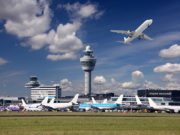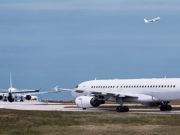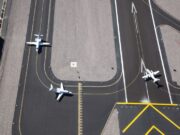
The year 2012 set records globally for the fewest major accidents involving commercial jets and commercial turboprops. The decreasing trend in the commercial jet accident rate was extended. The 2011 record rate, 0.28 major accidents1 per million departures for commercial jets, was reduced by 50 percent to a record low of 0.14. For the second year in a row, there were no commercial jet upset aircraft accidents.
But the increase in controlled flight into terrain (CFIT) accidents continued. Three of the seven commercial jet accidents were CFIT. Commercial turboprops also set a record low for the number of major accidents, although CFIT again dominated their fatality numbers. Business jets had 13 major accidents, slightly above their 12-year average.
There are now more than 22,000 commercial jets in the world. Of these, approximately 5 percent are Eastern-built. The world’s commercial turboprop fleet is 20 percent Eastern-built. About 9 percent of the total commercial jet fleet is inactive, including almost 50 percent of the Eastern-built aircraft. Fifteen percent of the 6,012 turboprops are inactive. For the third year in a row, there were inactive business jets, including 3 percent of the inventory.
The commercial jet inventory grew about 1 percent from the 2011 numbers, while the commercial turboprop inventory decreased 2 percent. The business jet inventory continued to lead in growth, with the current inventory of 17,642 aircraft representing a 2.5 percent increase from the previous year.
Seven major accidents involving scheduled and unscheduled passenger and cargo operations, for Western- and Eastern-built commercial jets, occurred in 2012 (Table 1). Six of the seven were approach and landing accidents. Three of the seven were CFIT, and there were two runway excursion accidents.
Figure 1 shows the total number of major accidents, including those involving Eastern-built aircraft, for commercial jets during the past 12 years. The overall number of accidents in 2012 was down dramatically. Even though only about 3 percent of the active commercial jet fleet is Eastern-built, they accounted for 43 percent of the major accidents.
Figure 2 shows the commercial jet major accident rate and the five-year running average. This rate is only for Western-built jets because, even though we know the number of major accidents for Eastern-built jets, we do not have reliable worldwide exposure data (hours flown or departures) to calculate valid rates for them. After a decade of an almost constant major accident rate for commercial jets, we now see a trend of improvement.
Business jets had 13 major accidents in 2012 (Table 2). This is slightly greater than their 12-year average of 10.5. Calculating accident rates for business jets is difficult due to the lack of reliable exposure data. One rate that can be calculated is the number of major accidents per 1,000 aircraft. Using that metric shows the improvement in the business jet accident rate over the past eight years (Figure 3).
The 17 major accidents involving Western- and Eastern-built commercial turboprops with more than 14 passenger seats in 2012 (Table 3) were well below the 12-year average of 25.9. The past 12 years of turboprop accident numbers show the record low in 2012 (Figure 4). Unfortunately, CFIT continues to dominate the fatality numbers for commercial turboprops. In 2012, four of the 17 major accidents (24 percent) were CFIT. Over the past six years, 28 percent (more than one in four) of the commercial turboprop major accidents have been CFIT.
CFIT, approach and landing, and upset aircraft accidents continue to account for the majority of accidents and cause the majority of fatalities in commercial aviation. There were only seven commercial jet accidents in 2012, but six of the seven (86 percent) were approach and landing accidents, and three of the seven (43 percent) were CFIT.
The upward trend of CFIT accidents for all commercial jets since 2009 (Figure 5) is disturbing, particularly because more than 95 percent of commercial jets have been equipped with terrain awareness and warning systems (TAWS) since 2007. During the past six years, there have been 37 commercial aircraft CFIT accidents (14 jet, 23 turboprop). In the past two years, more than 50 percent of the commercial jet fatalities have been caused by CFIT accidents.
In 2006, upset aircraft accidents took over from CFIT as the leading killer in commercial aviation. Over the past two years, commercial jets have suffered six CFIT accidents and no upset aircraft accidents. Because of this, CFIT is about to regain its title as the leading killer.
But until then, upset aircraft accidents still are the leading killer in commercial aviation. In keeping with the terminology in the 1998 Airplane Upset Recovery Training Aid, an aircraft is considered upset if one of the following conditions is met: pitch attitude greater than 25 degrees nose up; pitch attitude greater than 10 degrees nose down; bank angle greater than 45 degrees; within the previous parameters, but flying at airspeeds inappropriate for conditions. “Upset aircraft” accidents include accidents involving related terms such as loss of control, lack of control, unusual attitude, stall, extended envelope and advanced maneuvering.
An upset aircraft accident is one in which the aircraft is upset and unintentionally flown into a position from which the crew is unable to recover due to either aircrew, aircraft or environmental factors, or a combination of these. Another term used to describe these accidents is “loss of control.” This is a somewhat misleading term, because in 48 percent of the “loss of control” accidents over the past 10 years, there was no literal loss of control — the aircraft responded correctly to all control inputs. However, in 100 percent of the currently classified “loss of control” accidents, the aircraft was upset. There currently are more than 15 international efforts under way to address airplane upset prevention and recovery. The lack of any commercial jet upset accidents over the past two years indicates that these efforts may be seeing some success.
James M. Burin was the director of technical programs at Flight Safety Foundation.
Note
- The term major accident was created by Flight Safety Foundation in 2006. It refers to an accident in which any of three conditions is met: The aircraft is considered destroyed, as calculated by dividing the estimated cost of repairs to the hypothetical value of the aircraft had it been brand new at the time of the accident; or there were multiple fatalities to the aircraft occupants; or there was one fatality and the aircraft was substantially damaged. This criterion ensures that the categorization of an accident is not determined by an aircraft’s age or its insurance coverage.










